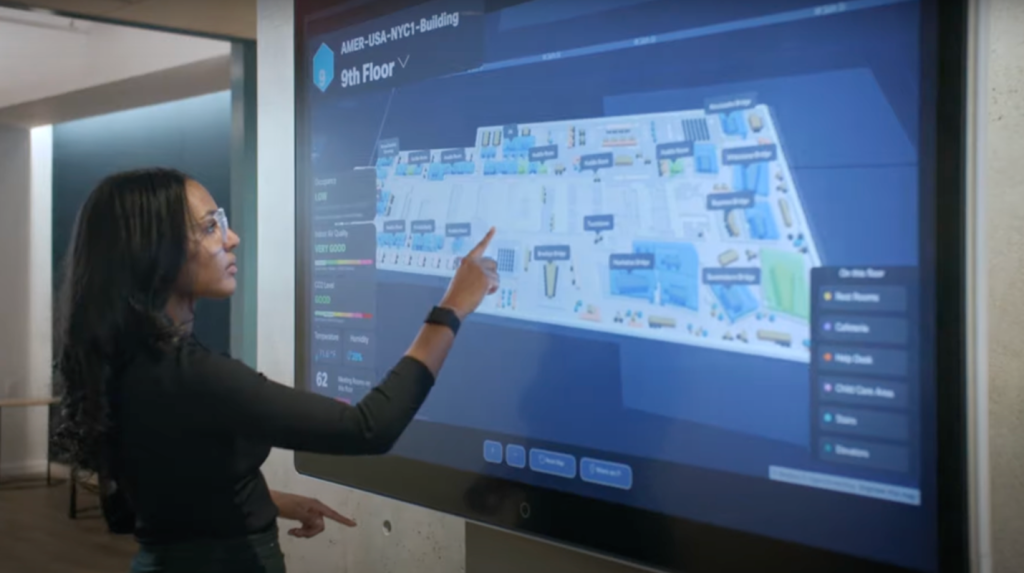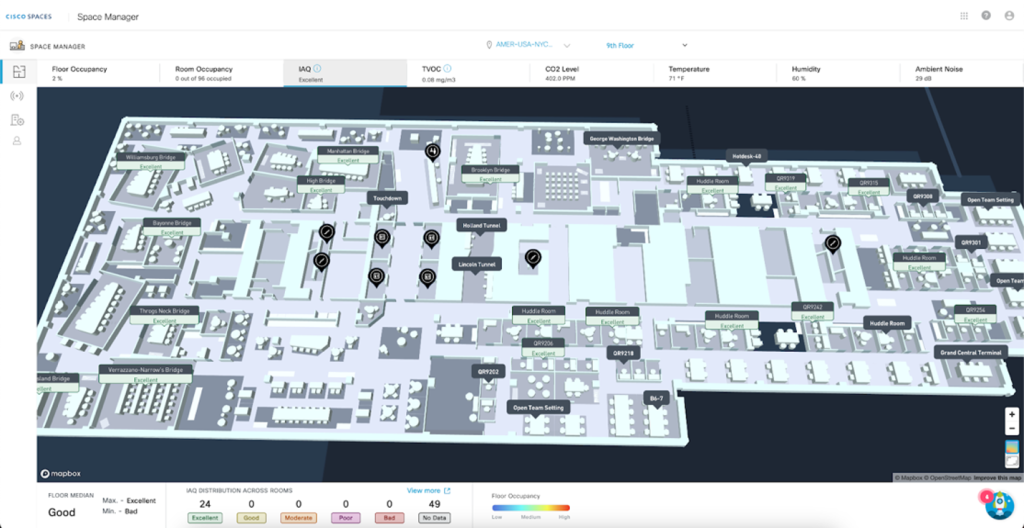The wildfire smoke that blanketed much of the Northeast and Central U.S. this past summer underscores the importance of air quality in office buildings. With increased awareness about safety and well-being post-pandemic, employees want assurance that their workplaces are safe.
A study by Carbon Lighthouse found that 82 percent of millennials felt safer returning to offices with real-time indoor air quality monitoring. Luckily, today’s state-of-the-art air quality solutions allow enterprises to track and provide employees with a real-time look at indoor factors like air quality, temperature, humidity, and building occupancy. In addition to monitoring, enterprises can also enable solutions that turn their buildings into spaces that are safer, smarter, and more energy efficient.

At most Cisco offices, employees and guests are greeted by digital signage when they walk in, showing an overview of indoor air quality, including total volatile organic compounds (TVOC), temperature and humidity, and ambient noise levels, in addition to how many people are in the building.
Given the ongoing situation with wildfire smoke, our indoor air quality monitoring solution has come as a big relief to employees, especially in our New York City offices. While much of the outdoor air remains “very unhealthy” or “hazardous,” and employees must resort to wearing N95 respirators to protect themselves when outdoors, they are reassured when they have a clear understanding of the indoor air quality.
In addition to air quality information, these interactive touch screens can also display vacant meeting rooms and amenities within the building, allowing employees to choose a room based on their comfort preferences.

Air quality monitoring is not just about helping employees. Facilities teams receive real-time insights on the ambient conditions of the workplace and monitor air quality within the building, on specific floors, or even within individual rooms (displayed on a 3D map) through the Cisco Spaces web-based dashboard.
If the air quality falls outside the preset normal range, the system automatically sends out an alert to building managers so they can take necessary action. In the case of wildfires, since outdoor air is polluted, building managers can close off outdoor ventilation and improve filter efficiency. Likewise, if an indoor pollutant source is identified, they can increase outdoor ventilation by letting more fresh air in to improve air quality. Cisco Spaces also provides historical analytics on all the above, allowing for better decision-making by facilities and environmental health and sustainability teams and adherence to building certifications.

Working behind the scenes to enable all of this is our robust Cisco network and collaboration hardware and a smart spaces cloud platform, Cisco Spaces.
Cisco Spaces leverages the following Cisco hardware and devices as a sensor for creating safer spaces, without the need to deploy expensive proprietary overlay solutions:
- Cisco Catalyst 9136 Series Access Points have built-in environmental sensors
- Cloud-managed Meraki MT indoor air quality sensors
- Cisco Webex comes embedded with a set of environmental sensors to understand the environment workers are in
- Cisco Spaces IoT Device Marketplace offers compatible third-party air quality, temperature, humidity, and Co2 sensors, as well as occupancy sensors
In addition to indoor air quality, Cisco Spaces enables real-time occupancy monitoring for workspaces to monitor real-time occupancy (another crucial safety metric) and sends out alerts to relevant teams when overcrowding is detected.
Indoor air quality beyond health and safety
Employees are now cautious about how much time they spend inside the office. Knowing that the air they are breathing is safe or the floor they are working on is not crowded is a welcome assurance. In addition, this data can be used for reporting to adhere to building certifications, standards, and guidelines.
Beyond health and safety, recent studies have shown that air quality can impact productivity and cognition. A study by Harvard University researchers found that increased concentrations of fine particulate matter (PM2.5) and lower ventilation rates impacted employees’ cognitive function, ability to focus and overall productivity.
A European Union Commission study found that buildings contribute to 33 percent of greenhouse emissions and 40 percent of global energy consumption. Most buildings operate on set points with heating, ventilation, and air conditioning (HVAC) and are typically programmed based on assumptions of when occupants will be in the building.
With hybrid working, predicting occupancy becomes difficult. Cisco Spaces leverages Cisco network infrastructure to provide occupancy data that can be used to optimize HVAC and lighting systems, ensuring energy is used only where and when it’s needed. Through integrations with building management systems such as Honeywell and Schneider Electric, real-time and historical indoor location data from Cisco Spaces is used to make actionable and predictive decisions that can help reduce operational costs and achieve energy and occupant-experience goals. In a study by Sensible Building Science, education customers have reduced total energy savings by up to 22 percent using occupancy data from Cisco hardware and Cisco Spaces to adjust building HVAC.
Most buildings also operate maintenance and cleaning on preset schedules. But this is not always the most efficient use of resources. With Cisco Spaces, real-time and historical occupancy data is analyzed to make informed decisions on resource allocation for cleaning, maintenance, and catering.
Smarter spaces are safer spaces
Wildfires or not, employees deserve the assurance that their workplaces are safe, and assuring them of healthy, breathable air, is an important step in that direction. Cisco Spaces is continuously evolving to predict the growing needs of hybrid workplaces and improve the workplace experience. In addition to air quality monitoring, with outcomes like improved productivity with a digital meeting room finder, occupancy-based energy management, and office space optimization, Cisco Spaces gives new meaning to the term “smart buildings.”
Want to understand and manage indoor air quality and occupancy in your buildings?
Get in touch with us at Spaces.cisco.com


CONNECT WITH US